Recent Articles
Popular Makes
Body Types
2015 Jeep Cherokee Review and Quick Spin
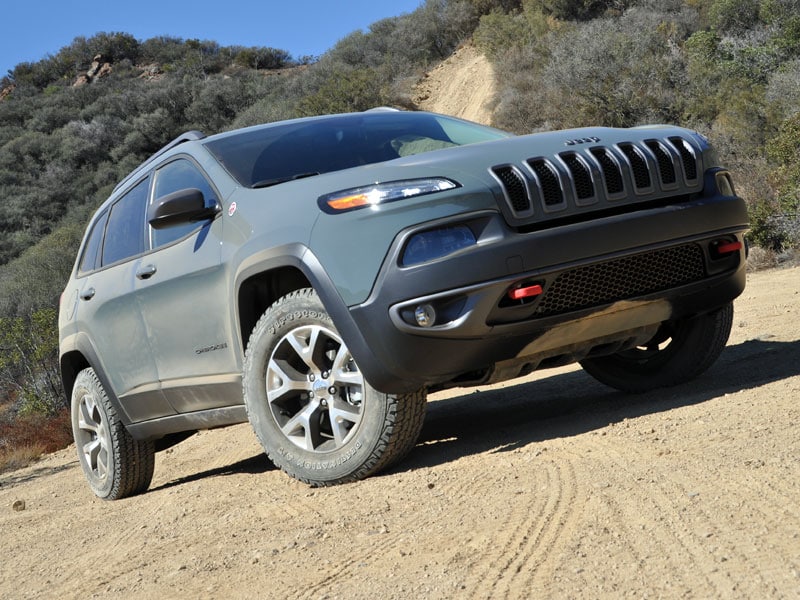
2015 Jeep Cherokee Trailhawk Anvil Paint Off Road Front Quarter Right ・ Photo by Christian Wardlaw
There are three different kinds of Jeep Cherokee. First, there is the kind that might as well be a car, equipped with front-wheel drive and zero intention of performing anything remotely resembling a Jeep Thing. Second, there is the kind that is a weather-beating crossover SUV, equipped with automatic 4-wheel drive to get it from wherever you are to wherever you want to be whenever a blizzard strikes. Third, there is the kind that gets a “Trail Rated” badge, equipped with a sophisticated 4WD system that can take you just about anywhere you want to go.
That last one is my favorite, the 2015 Jeep Cherokee Trailhawk pictured here. But if you’re not planning to stray far from the pavement, the other versions also deserve consideration.
About Our Test Vehicles
I drove two versions of the 2015 Cherokee at a daylong demonstration event near Los Angeles. Shown here is the Cherokee Limited, equipped with a 3.2-liter V-6 engine and the most basic Jeep Active Drive I all-wheel-drive setup, which I kept on pavement aside from driving into a dirt lot for photos.
The other Cherokee is the Trailhawk model, which comes standard with the most robust 4WD system available, along with all kinds of other modifications designed to make it trail-ready right out of the showroom. This one saw serious off-roading action in the mountains near Malibu, California.
For 2015, Jeep adds automatic stop/start technology for the Cherokee’s optional V-6 engine in order to make it just a little more fuel-efficient. At the same time, the standard 2.4-liter 4-cylinder engine now meets Partial Zero Emission Vehicle (PZEV) standards in several U.S. states.
Jeep has also shuffled equipment this year, adding a standard reversing camera and automatic headlights for all models except the base Cherokee Sport, as well as a new SafetyTec option package. Trailhawk models are available with additional upscale upgrades this year, and the optional forward collision warning system is now equipped with a low-speed crash mitigation system.
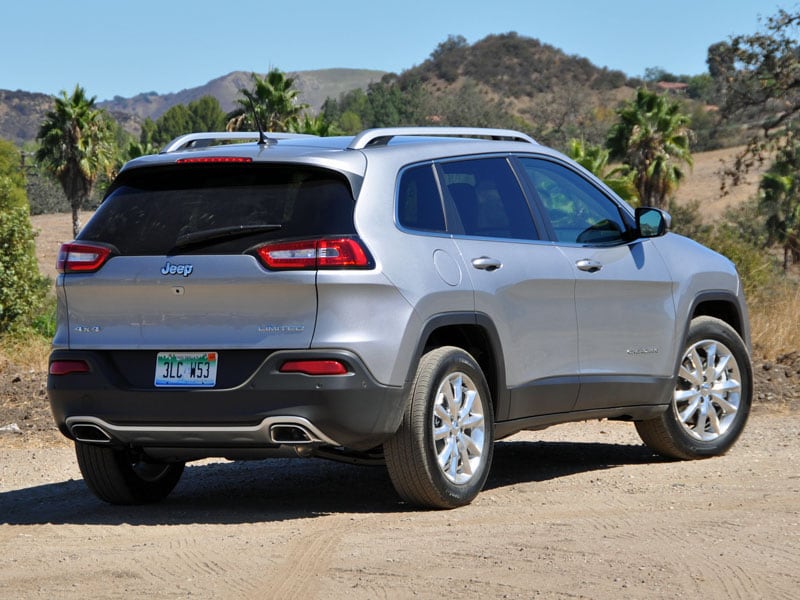
Photo by Christian Wardlaw
Comfort and Cargo
Jeep markets the Cherokee as a mid-size SUV, and in terms of passenger space that represents credible positioning. Both test vehicles had an 8-way power adjustable driver’s seat providing me with a tall perch, excellent thigh support, and an expansive view out. Elbows rest on soft materials, and the thick, leather-wrapped steering wheel is great to grip.
The rear seat also offers decent room, especially if the driver and front passenger refrain from reclining their seatbacks much. People relegated to riding in back sit up nice and high, enjoying plenty of thigh support as well as decent room for knees, shins, and feet. Plus, the seat slides forward and back to help Cherokee owners create the right mix of room for people and cargo.
Still, where the Cherokee falls short, at least as far as its midsize positioning is concerned, is with regard to cargo space. With the rear seat moved all the way back, the Cherokee supplies 24.6 cu.-ft. of it, substantially less than most compact crossover SUVs. Maximum volume measures 54.9 cu.-ft., about a Miata’s worth more than a Kia Soul.
With that said, the Cherokee’s hidden compartments under the front seat cushion and cargo floor, the fold-flat front passenger’s seat, a cargo management system, and other thoughtful storage solutions help to make up for the small cargo volume numbers.
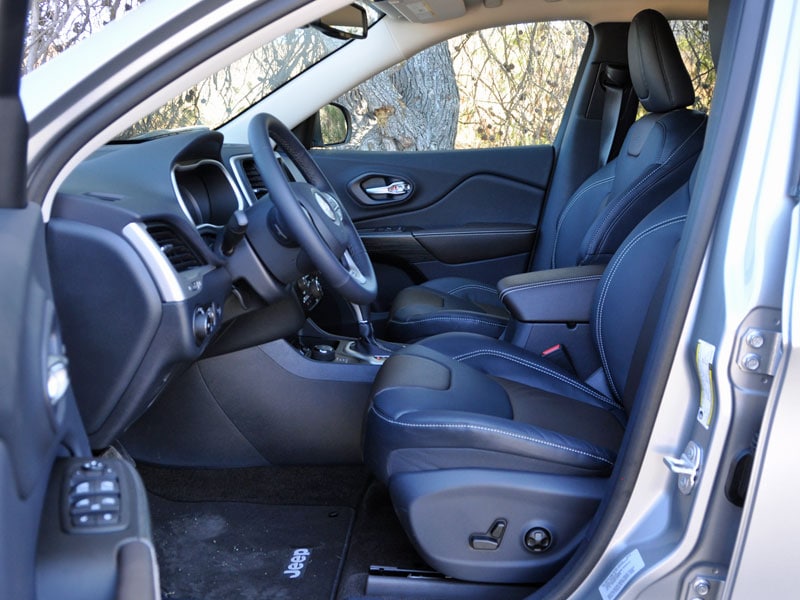
Photo by Christian Wardlaw
Features and Controls
Though the Cherokee is a midsize player from a mainstream brand, it is innovative beyond its polarizing design. From the available configurable instrumentation display nestled between the gauges to the optional Uconnect infotainment system with a big 8.4-inch color touchscreen display and Uconnect Access smartphone pairing technology, the Cherokee is a thoroughly modern SUV. You can even turn it into a mobile Wi-Fi hot spot and charge your smartphone on the available wireless charging pad.
Better yet, the Cherokee’s high-tech nature doesn’t translate into a vehicle that is difficult to use. No matter what you’re looking for, chances are that you’ll find it right where you expect to. The controls work intuitively and with a sense of refinement, and the Uconnect 8.4 system is one of my all-time favorites in terms of clarity, simplicity, and touchscreen responsiveness.
Jeep also offers parking sensors and an adaptive cruise control system for the Cherokee, complete with stop-and-go capability, which means it will automatically brake to a stop and then resume speed, allowing it to be used in traffic. The optional parallel and perpendicular parking assist system, though, I could live without.
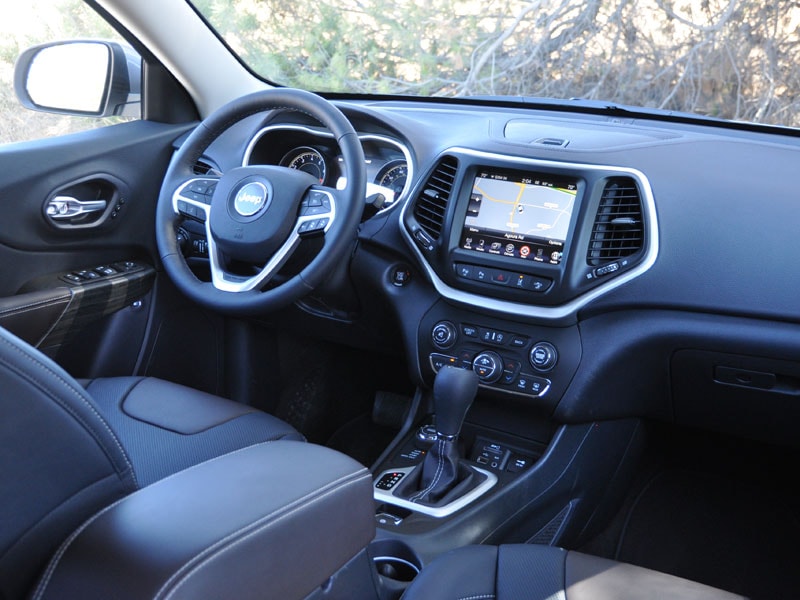
Photo by Christian Wardlaw
Safety Matters
Every 2015 Cherokee is equipped with 10 airbags. To this, buyers can add Uconnect Access with 911 Assist technology, which puts the Cherokee’s occupants in touch with an emergency services operator with the push of a button. All models except for the Cherokee Sport include a reversing camera as standard equipment.
In addition to these safety-related features, and depending on the trim level selected, the 2015 Cherokee is offered with a blind spot monitoring system with rear cross-path detection, a LaneSense lane departure warning system, and a forward collision warning system that is enhanced for 2015 with new technology designed to prevent, or substantially lessen, impacts at lower vehicle speeds.
In crash tests, the NHTSA gives the 2015 Cherokee a 4-star overall rating. Note that the Jeep earns 4 or 5 stars in every single assessment, including rollover resistance. The Insurance Institute for Highway Safety (IIHS) had not tested the 2015 Cherokee as this review was written, but last year gave the SUV top marks in all but the small overlap frontal-impact test, for which it had not yet been rated.
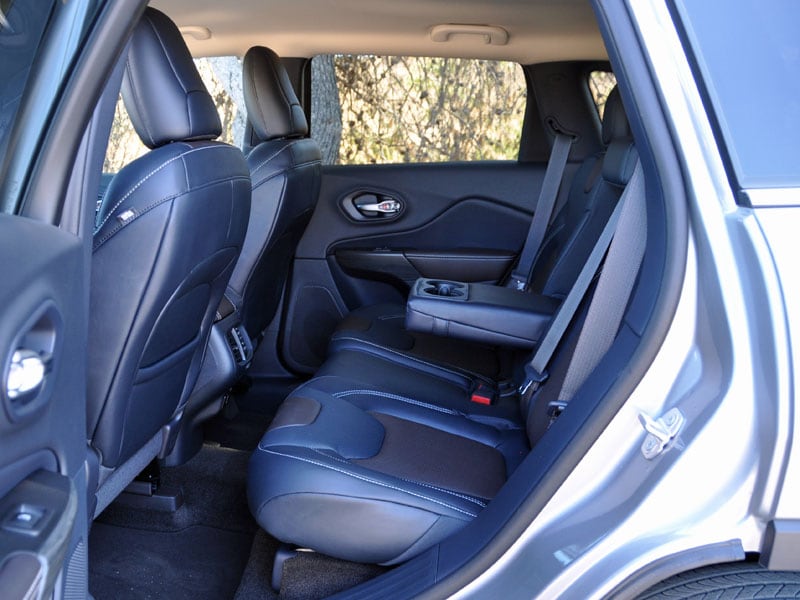
Photo by Christian Wardlaw
What's Under the Hood
You can get a Jeep Cherokee equipped with a 184-horsepower, 2.4-liter 4-cylinder engine, but why? The fuel economy benefit is negligible, and the optional 271-horsepower, 3.2-liter V-6 is far more satisfying. Yes, it does cost $1,495, but it will be money well spent. Trust me.
Both engines are bolted to a 9-speed automatic transmission, and front-wheel drive is standard for all versions except the Trailhawk. If you consider that fact equivalent to blasphemy, resolve it by selecting from one of the three 4WD system options.
Jeep Active Drive I is a fully automatic 4WD system that distributes power to the rear wheels whenever necessary to improve traction. This system also includes a rear-axle disconnect to improve fuel economy. Jeep Active Drive II adds low-range gearing and a Neutral mode for flat-towing behind an RV. Jeep Active Drive Lock adds a rear locking differential, and is standard for the Cherokee Trailhawk model.
In addition to these 4WD systems, the Cherokee is available with hill ascent and descent control systems as well as a Selec-Terrain traction control system with Auto, Snow, Sport, Sand/Mud, and Rock settings.
If you’re planning serious off-roading excursions, buy the Cherokee Trailhawk. In addition to the Jeep Active Drive Lock 4WD system, it includes unique 17-inch wheels with all-terrain tires, a one-inch suspension lift, revised front and rear styling to improve approach and departure angles, skid plates, tow hooks, and a 56:1 crawl ratio. Jeep says the Trailhawk can also ford water up to 20 inches deep.
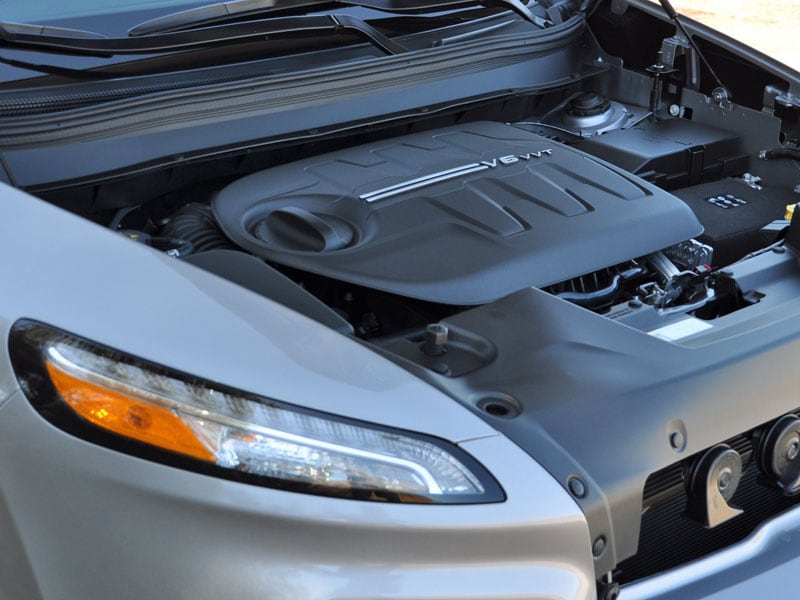
Photo by Christian Wardlaw
Driving Impressions
I took a Jeep Cherokee Limited with a V-6 engine for a drive in the suburbs and local mountain roads near Los Angeles, averaging 22.5 mpg in the process, which is exactly what the EPA thinks a Cherokee with 4WD should get.
Aurally, the driver notices when the new automatic engine stop/start system shuts the engine off, an action that is accompanied by a subtle vibration and a change in climate control operation, but this is not bothersome. More important, the system re-starts the V-6 engine faster than the driver can get his or her foot from the brake pedal to the gas pedal. Again, there is a subtle vibration, but it does not detract from the powertrain’s overall refinement.
The V-6 provides decent acceleration, though I wouldn’t characterize the Cherokee as quick. That’s why I urge you to skip the 4-cylinder for the stronger motor. As for the 9-speed automatic transmission, aside from occasional indecisiveness, it works in remarkably unobtrusive fashion. I’m also a fan of the Cherokee’s steering and brake response, and the tight turning circle comes in handy in parking lots as well on tough mountain trails.
Speaking of which, I was able to take a Cherokee Trailhawk on a private off-roading course near Malibu, California. The terrain here is rugged, and Jeep used the venue to demonstrate exactly what the most capable version of the Cherokee can do.
With the Active Drive Lock 4WD system placed in 4-Lo, and the Selec-Terrain system set for Sand/Mud, off I drove into the wilderness. Normally, I find serious off-roading to be a far more petrifying proposition than zooming around a racetrack at triple-digit speeds, but with an understanding of how the Cherokee’s drivetrain works and what the Cherokee can do, I scrambled up the trail with a degree of confidence that I’d return to base camp in one piece.
Offering plenty of engine grunt and wheel articulation, the Cherokee ascended the mountain with ease, making it across one particularly nasty stretch of trail moguls that had Selec-Terrain working overtime to determine the best distribution of power to the wheels. More impressive, though, is how Jeep Active Drive Lock, the hill descent control system, and the Selec-Terrain system worked together to get the Cherokee down a very slippery and steep slope with minimal drama. I was totally freaked out, but the Cherokee remained calm, cool, and collected.
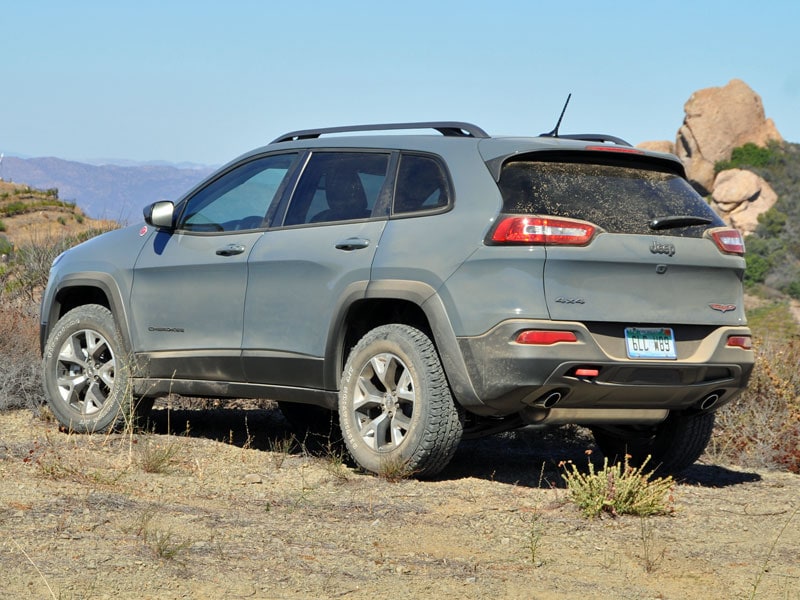
Photo by Christian Wardlaw
Final Thoughts
Some people aren’t all that crazy about the Jeep Cherokee’s styling, and that’s understandable. It isn’t designed to appeal to everyone, and that’s actually a good thing. It helps to ensure that the Cherokee has personality, and that its owners are passionate about their SUV.
Beyond the surface, though, you should know that the Cherokee is an exceptionally well-rounded vehicle that performs daily driving tasks with the comfort and efficiency of a crossover but, especially when decked out in Trailhawk livery, can still tackle serious terrain like a traditional SUV.
Jeep invited Autobytel to a one-day driving event to facilitate this review
2015 Jeep Cherokee photos by Christian Wardlaw
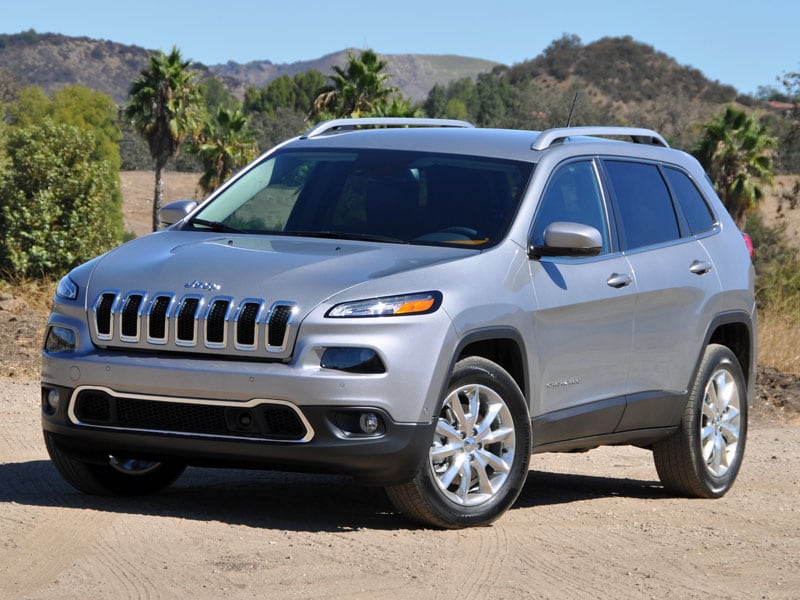
Photo by Christian Wardlaw